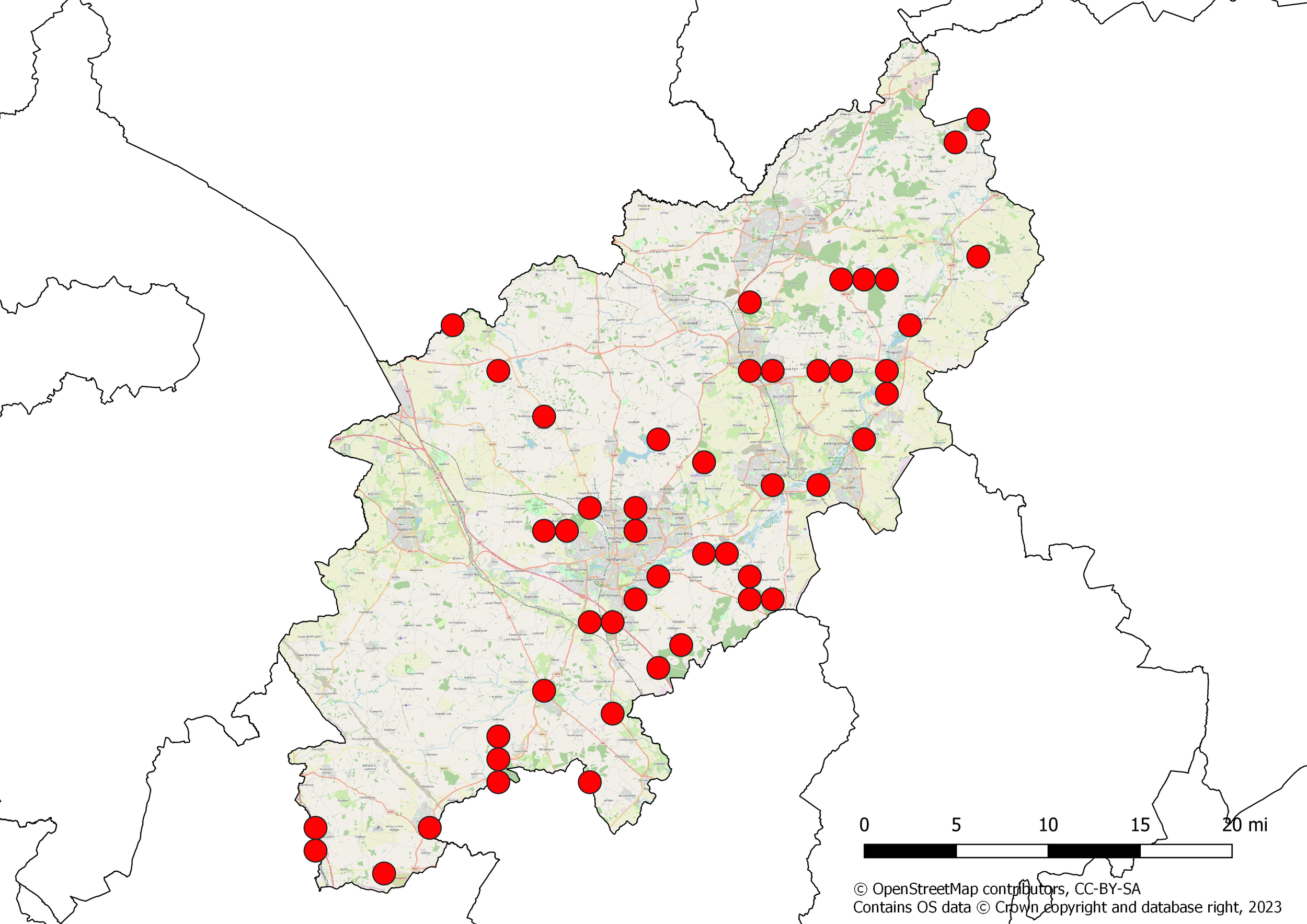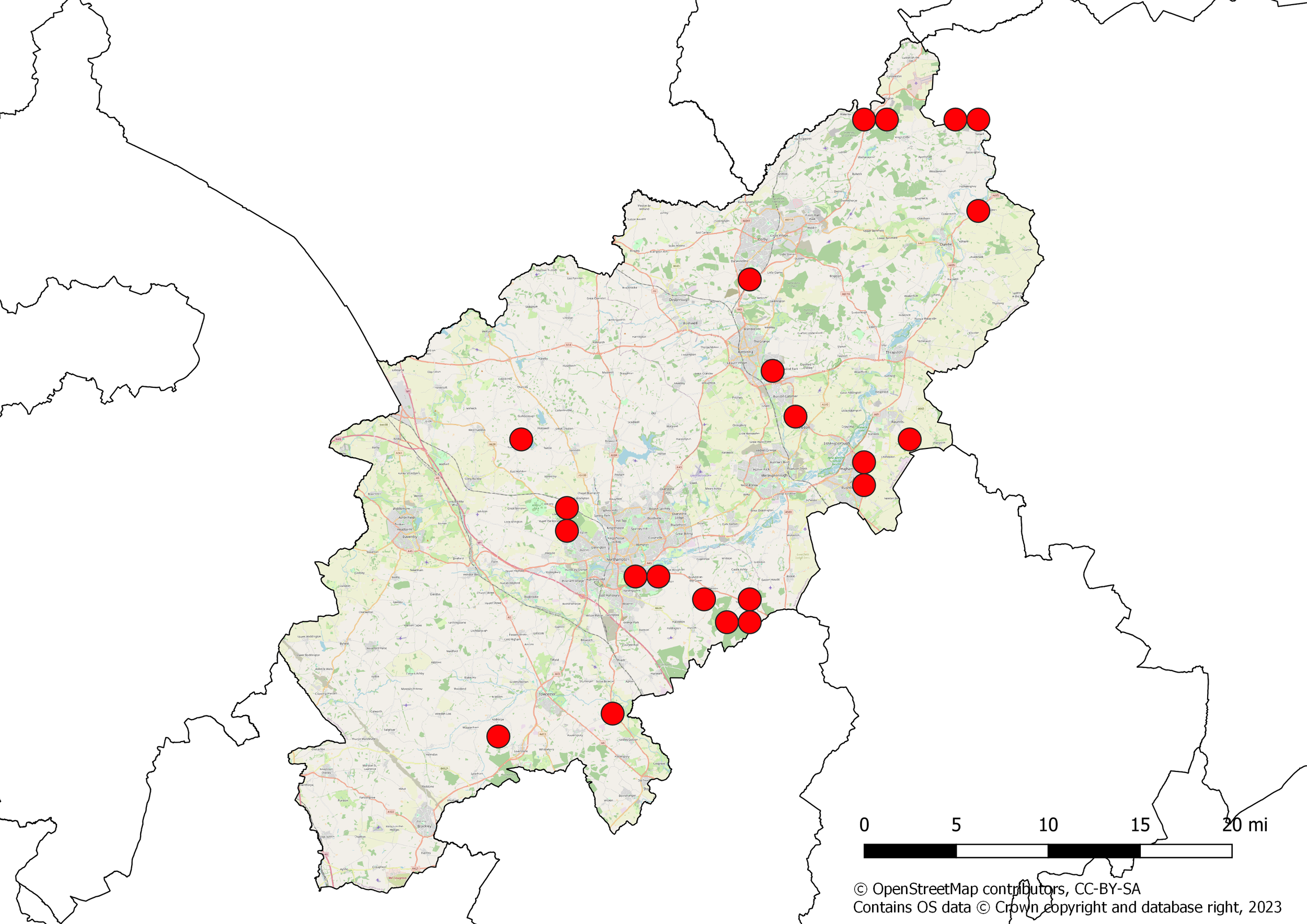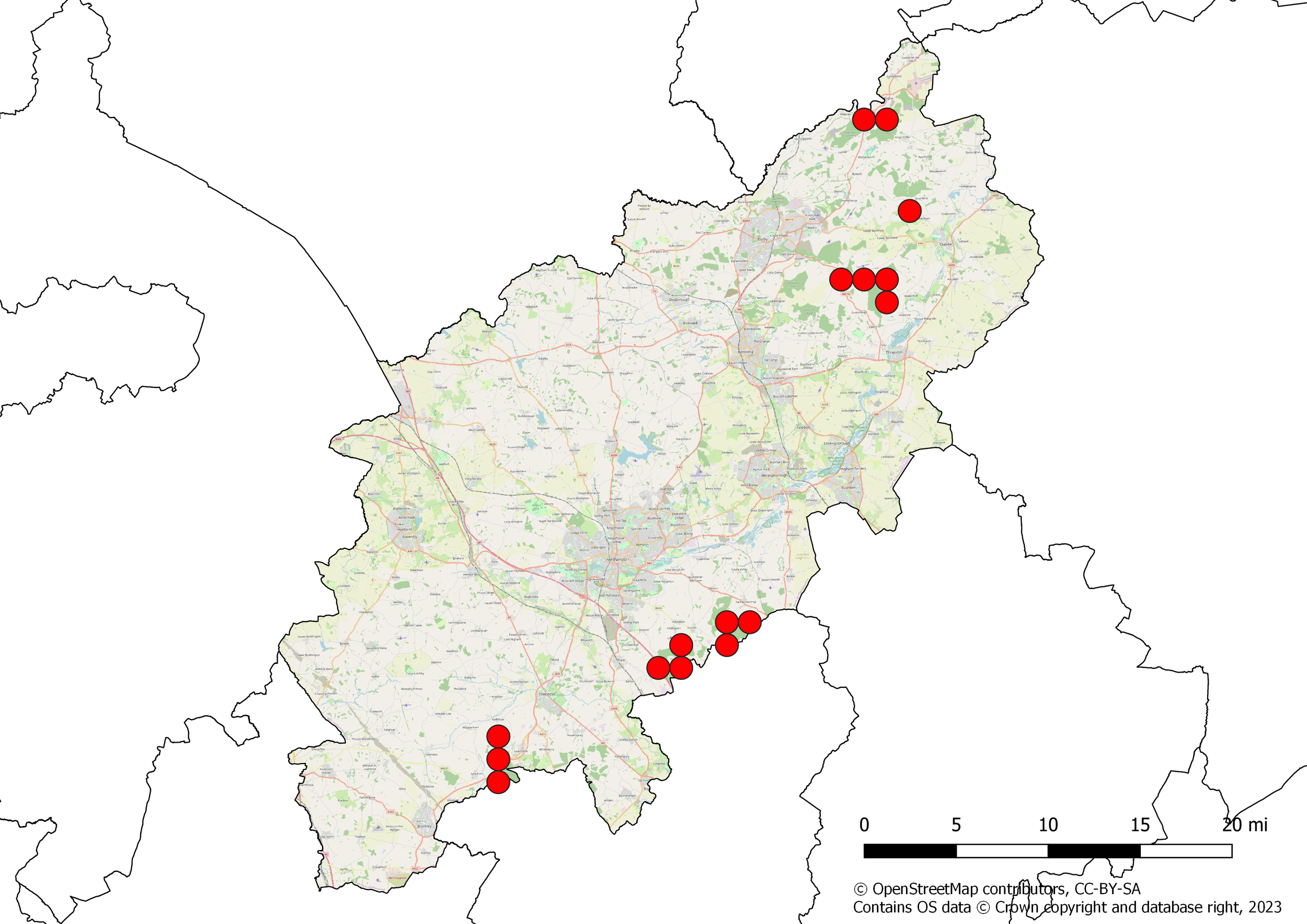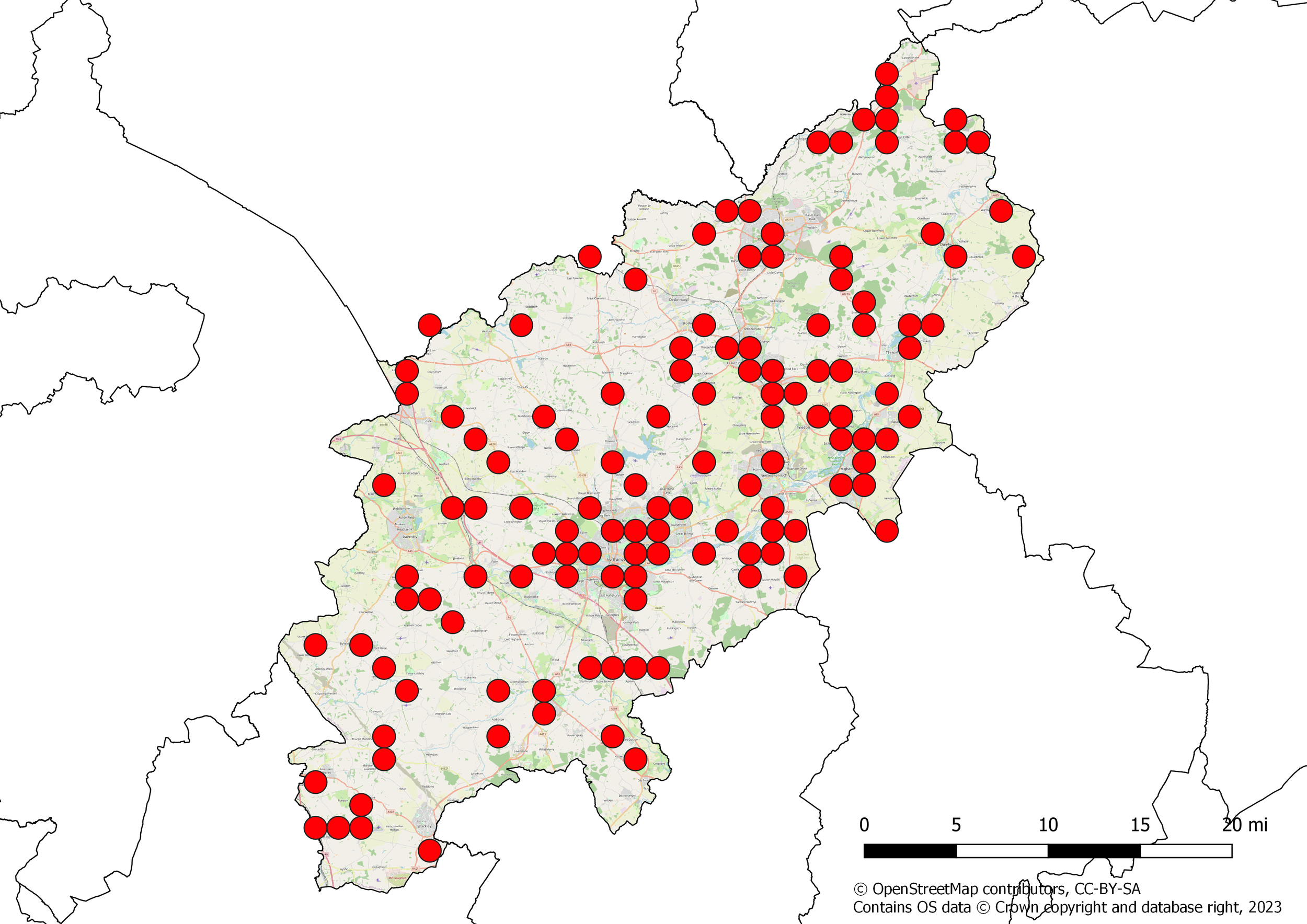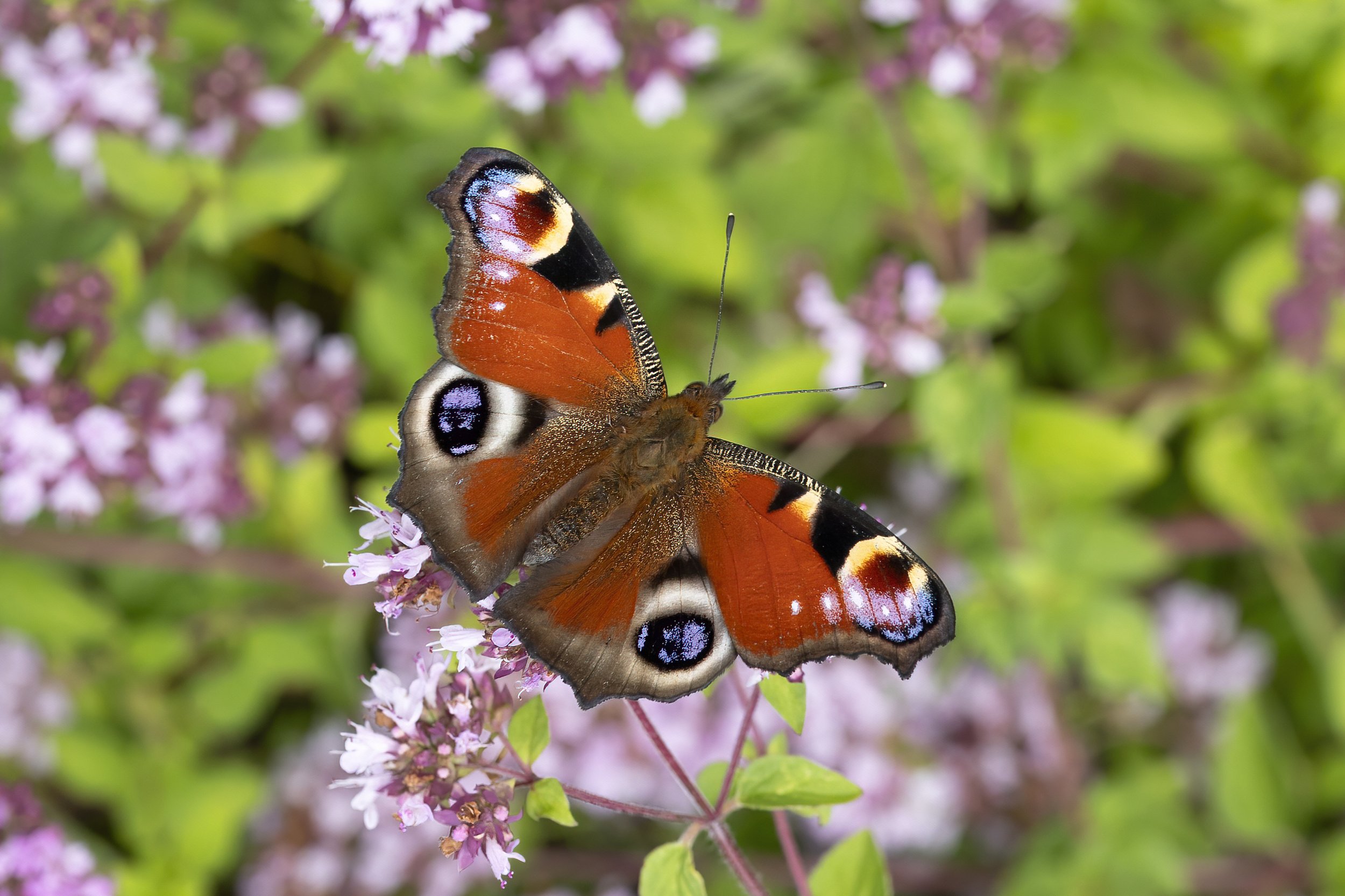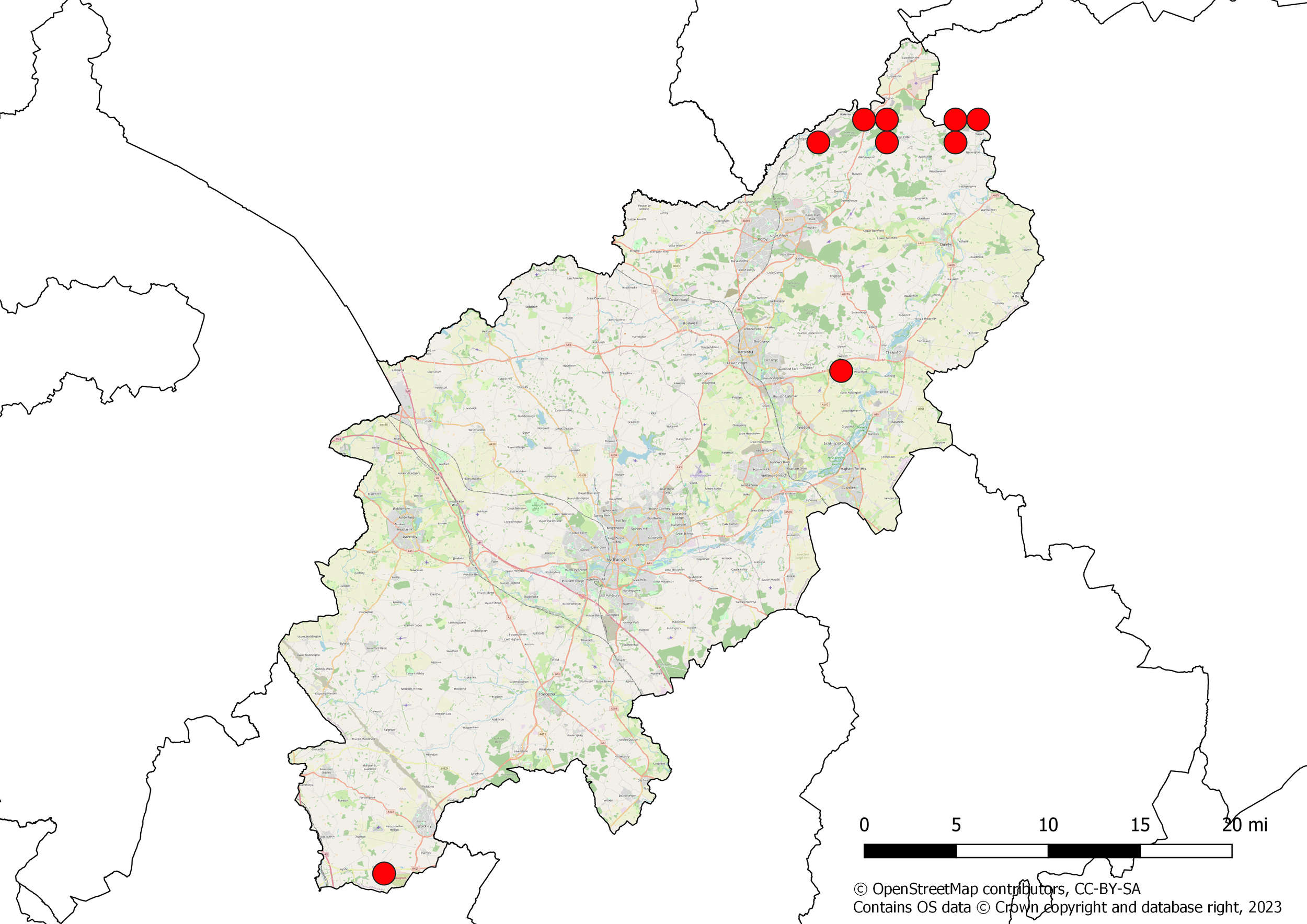The Butterflies of Northamptonshire in 2023
I am very pleased to report that 2023 proved to be another record-breaking year for recording butterflies in Northamptonshire. In total, I have received 31,136 records detailing the whereabouts of 105,448 individual adult butterflies. This is a phenomenal achievement and a new county record! I would like to extend a huge thank you to all of those who took the time to record the butterflies they were seeing. The records came from a variety of sources including the UKBMS transect surveys, the WCBS wider countryside surveys, timed counts from local projects such as the Chequered Skipper Project, the Garden Butterfly Survey, the Big Butterfly Count and casual recording. All this data is combined to create one large database which will then be sent to Butterfly Conservation and the Northamptonshire Biodiversity Records Centre. Weatherwise 2023 proved yet again to be a rather mixed bag with unsettled and cold conditions dominating early spring. Despite the occasional downpour June was a more settled warmer month, but July was dominated by seemingly never-ending bands of cloud cover and rain. Fortunately, conditions improved in late summer and into autumn, with long periods of settled weather and lots of sunshine. These ups and downs in the weather are certainly reflected in the records. Some spring and mid-summer species were very much down, while the Black Hairstreak, which took advantage of the warm spell in June, had the second-best year ever recorded, the Red Admiral invasion saw them being recorded in unprecedented numbers, and the end of the year saw some huge news as the Brown Hairstreak has returned to the county after an absence of over half a century! However, while I frustratingly lost days of potential recording when I had to remain indoors due to the inclement conditions outside, this did allow me the opportunity to realise a dream I have had for quite a while now. Many years ago, when I was starting to find my feet as a naturalist, I quite quickly came to realise just how important local knowledge is when looking for wildlife, and of course, this includes butterflies. I was lucky enough to have some incredible mentors who took the time to not only show me the local sites but also how to be a naturalist and see, study, and record nature in a new way. Such was the impact these people had on me I always told myself that when I had that knowledge, I would use it to help others experience the wonderful wildlife that Northamptonshire has to offer. So, this year I created the Northants Butterflies website (www.northantsbutterflies.com) to help people experience our local butterflies and find their way around some of our key butterfly sites. There are also identification guides to help you tell some of the similar-looking species apart, and a tutorial on how to record the butterflies you are seeing. In other news, we are incredibly fortunate to continue to benefit from the Chequered Skipper project in the Rockingham Forest area in the north of the county, which carries out brilliant conservation work for not just the Chequered Skipper, but also many other species. This year also saw the launch of the incredibly exciting Threatened Species Recovery project in Northamptonshire’s woodlands which will help a variety of woodlands species. That’s it from me for now, I hope you enjoy the new website and reading this 2023 annual review.
David James - Northamptonshire County Recorder for Butterflies
2023 Monad Coverage
Chequered Skipper
Like many of the other spring butterflies, the number of Chequered Skippers recorded was fewer this year, no doubt affected by the poor weather. However, there was still a good spread of records around Fineshade Wood, and the butterfly does seem to be moving into new areas which is very encouraging indeed. For more information about this fantastic reintroduction project please see the Chequered Skipper Taking Flight in Rockingham Forest page in Butterfly Conservation’s website.
Chequered Skipper
Chequered Skipper
Small, Essex and Large Skipper
All three of Northamptonshire’s Golden Skippers did well in 2023. The Small Skipper shows an increase of 30% above the previous year, which is 56% above the five-year average. The Essex Skipper had a 19% increase in abundance from the previous year, which is 9% above the five-year average, and the Large Skipper saw a 46% increase in numbers above the previous year, which is 17% above the five-year average. All of these grassland butterflies could be encountered at sites with suitable habitat. The first Small Skipper was recorded on the 16th of June in Fineshade Wood, and the last ones were recorded on the 20th of August at Ring Haw and Harrington Airfield. The first Essex Skipper was recorded on the 22nd of June at Stanwick Lakes, and the last of the year was recorded on the 19th of August in Salcey Forest. The first Large Skipper was recorded on the 1st of June just inside the county boundary near Market Harborough and the last of the year was recorded on the 23rd of August in Fineshade Wood.
Essex Skipper
Small Skipper Distribution
Essex Skipper Distribution
Large Skipper Distribution
Dingy Skipper
The Dingy Skipper had a poor year in the county during 2023, with their numbers no doubt affected by the cool and unsettled spring weather. They were 58% down in abundance from the previous year, which is a 34% drop below the five-year average. The best places to see them were Fermyn Country Park, Fineshade Wood, Harrington Airfield, Old Sulehay and Twywell Hills and Dales. The first of the year was recorded on the 3rd of May at Fermyn Country Park. The last ones were notable as they were from a second brood, which is quite rare in the county. One was recorded on the 29th of July at Spanhoe airfield and another was recorded on the 6th of August at Twywell Hills and Dales.
Dingy Skipper
Dingy Skipper Distribution
Grizzled Skipper
Similarly to the other spring Skippers the Grizzled Skipper had a poor showing in 2023. Its abundance was 21% down from the previous year, which puts it 12% below the five-year average. The best places to see Grizzled Skippers were Fermyn Country Park, , Fineshade Woods, Old Sulehay and Twywell Hills and Dales. The first one of the year was recorded on the 29th of April at Fermyn Country Park, and the last one of the year was recorded on the 23rd of June at Twywell Hills and Dales.
Grizzled Skipper
Grizzled Skipper Distribution
Wood White
The Wood White had an average year in Northamptonshire and while numbers were 7% below the abundance seen in 2022 this is just 0.7% below the five-year average for the species. The best public places to see Wood Whites were Bucknell Wood, Hazelborough Forest and Salcey Forest. Once again in 2023 straggling butterflies from the nearby colony in Geddington Chase were recorded in other woodlands in the local area including Harry’s Park Wood, Fermyn Wood and Weekley Hall Wood. The first of the year was recorded on the 10th of May in the Sywell Wood and the last of the year was recorded on the 15th of August in Yardley Chase.
Wood White
Wood White Distribution
Clouded Yellow
The Clouded Yellow had a very poor showing in the county in 2023 with just four butterflies recorded all year. The first of the year was recorded on the 21st of June in the garden of Kettering General Hospital, the second was seen on the 25th of August near Bugbrooke, the third was seen on the 6th of September at Summer Leys Nature Reserve, and the last one was recorded on the 29th of September along Towcester Road in Northampton. The abundance figures of migrant butterflies do fluctuate annually so let’s hope more visit our county next year.
Clouded Yellow
Clouded Yellow Distribution
Brimstone
The Brimstone had a good year in 2023. It was recorded with a 29% increase in abundance above the previous year, which puts it 40% above the five-year average. This butterfly could be encountered anywhere with suitable habitat but the best numbers were recorded at Brackmills, Bucknell Wood, Fineshade Wood, the Nene Wetlands, Old Sulehay and Ring Haw, and Summer Leys Nature Reserve. The first of the year was recorded on the 6th of February in Wootton, and the last ones of the year were recorded on the 23rd of November in Wilby and Fermyn Country Park.
Brimstone
Brimstone Distribution
Large, Small and Green-veined White
The Large White had a good season in 2023 and showed a 43% increase in records above the previous year, which places it 20% above its five-year average. The Small White was 26% above the previous year’s records which is 10% below the five-year average. The Green-veined White had an average year with numbers similar to 2022, which puts it just 1% below its five-year average. All three of these butterflies could be seen anywhere with suitable habitat. The first Large White of the year was recorded on the 4th of April at Stanwick Lakes, and the last of the year was seen on the 17th of October in Polebrook. The first Small White of the year was seen on the 2nd of April on the Westone Estate in Northampton, and the last of the year was recorded on the 9th of November in Wollaston. The first Green-veined White of the year was seen on the 2nd of April at Pitsford Nature Reserve, and the last of the year was seen on the 29th of September in Fermyn Country Park.
Large White
Large White Distribution
Small White Distribution
Green-veined White Distribution
Orange-tip
The Orange-tip had a very poor season in 2023, and like many of the other spring butterflies, I am sure the cold weather affected the numbers being recorded. The records show a 42% decrease in abundance from the previous year, which places it 31% below the five-year average. Despite this fall in numbers, the Orange-tip was still a common butterfly which could be found anywhere with suitable habitat. Some of the sites with the highest numbers were Hazelborough Forest, the Nene Wetlands, Salcey Forest, Stawnwick Lakes and Summer Leys Nature Reserve. The first of the year was recorded on the 17th of March in Corby. The last one of the year was seen on the 27th of July when a second-brood male was observed at Brixworth Country Park, second-brood Orange-tips are quite rare in Northamptonshire so this was an excellent find!
Orange-tip
Orange-tip Distribution
Brown Hairstreak
Quite possibly the biggest headline-grabbing butterfly news for Northamptonshire was the discovery of Brown Hairstreak eggs, proving their natural colonisation into the south of the county from Oxfordshire. This firmly places the Brown Hairstreak as a new breeding species for the county after an absence of over half a century, and a big pat-on-the back is in order for Brian Laney who found the first egg on the 20th of December along a footpath running south of RAF Croughton. A subsequent search on the 24th of December discovered another four more eggs within the county boundary. For more information about this incredible news please see my blog post here - The Brown Hairstreak Returns To Northamptonshire!
A Brown Hairstreak egg photographed near RAF Croughton
Brown Hairsreak Distribution
Green Hairstreak
The Green Hairstreak was significantly down in terms of abundance from the previous year and showed a 33% drop in records. However, this is only 4% below the five-year average and like many of the other spring butterflies the poor weather no doubt affected the numbers being recorded. The best places to see this localised butterfly were Harrington Airfield, Fermyn Country Park, Fineshade Wood and Twywell Hills and Dales. The first ones of the year were recorded on the 3rd of May at Collyweston Deeps and Fermyn Country Park, and the last one was seen on the 13th of June near Collyweston Great Wood.
Green Hairstreak
Green Hairstreak Distribution
Purple Hairstreak
The Purple Hairstreak had an average year in the county with a 33% increase in records from the previous year, and a 2% increase above the five-year average. However, what made the 2023 Purple Hairstreak season really stand out was the amount that were seen low down for prolonged periods of time. At some sites low down butterflies were recorded in large numbers and on the 7th of July 100+ counts were recorded in both Bucknell and Fermyn Woods. The best places to see the Purple Hairstreak was Bucknell Wood, Hazleborough Forest, the Fermyn Wood Complex, Plumpton Wood and Salcey Forest. The first one of the year was recorded on the 21st of June in Glapthorn Cow Pastures, and the last of the year was seen on the 20th of August at Pitsford Nature Reserve.
Purple Hairstreak
Purple Hairstreak Distribution
White-letter Hairstreak
Although the White-letter Hairstreak shows a 23% increase in adults recorded over the previous year, it is still 40% below the five-year average, and consequently remains a butterfly of serious local concern. Encouragingly, new sites are being discovered each year, and in 2023 Higham Ferrers and Stanwick Pastures were added, among others, to the list of current colonies. The best sites to see them were Brackmills Wood, Bucknell Wood, Fineshade Wood and around Harlestone. The first of the year was recorded on the 12th of June in Higham Ferrers, and the last ones of the year were seen on the 10th of August in Fineshade Wood and Harlestone.
White-letter Hairstreak
White-letter Hairstreak Distribution
Black Hairstreak
The Black Hairstreak had a superb flight period in Northamptonshire during 2023. The records show a 143% increase in abundance over the previous year, and a 37% increase in records above the five-year average, making it the second-best year on record for the species. The Black Hairstreak certainly benefited from a welcome break in the weather as the cold spring finally gave way to some warm and settled weather just in time for the butterfly’s emergence. The best places to see them were Glapthorn Cow Pastures, the Fermyn Wood complex and Salcey Forest. The first one of the year was recorded on the 11th of June in Salcey Forest, and the last of the year was seen on the 7th of July in Fermyn Woods.
Black Hairstreak
Black Hairstreak
Small Copper
The Small Copper saw a 3% drop in records compared with the previous year, which puts it 22% below the five-year average. As in most years the summer brood was significantly larger than the one seen in the spring. This is a common butterfly and can be recorded anywhere with suitable habitat, however, the sites with the greatest abundance were Harlestone Firs, the Nene Wetlands and Old Sulehay. The first one of the year was recorded on the 23rd of April at Boughton, and the last one of the year was seen on the 13th of October in Billing Road Cemetery in Northampton.
Small Copper
Small Copper Distribution
Brown Argus
The Brown Argus had a very good season in 2023 and was recorded in large numbers during its summer brood. The records show a 63% increase in abundance from the previous year and a 55% increase above the five-year average. This butterfly could be encountered anywhere with suitable habitat, but the sites where they were recorded in the largest numbers include Collyweston Deeps, Croughton Pocket Park, the Nene Wetlands, Old Sulehay and Ring Haw, and Twywell Hills and Dales. The first ones of the year were recorded on the 14th of May at Harrington Airfield and Quarry Walk near Earls Barton, and the last ones of the year were recorded on the 29th of September in Fermyn Country Park and Duston Quarry.
Brown Argus
Brown Argus Distribution
Common Blue
The Common Blue had a slightly less-than-average year. It was 28% down on the previous year which places it 13% down from the five-year average. In keeping with the Small Copper and Brown Argus the summer brood was recorded in much larger numbers than the spring brood and on one day on the 28th of August almost 300 were recorded around the clover fields south of Lower Benefield. This is a common grassland butterfly which can be encountered anywhere with suitable habitat. The best places to see them in 2023 were Fermyn Country Park, Fineshade Wood, Harrington Airfield, Lower Benefield, Lyveden New Bield, Old Sulehay and Ring Haw, and Twywell Hills and Dales. The first one of the year was recorded on the 28th of April in Wellingborough and the last one of the year was recorded on the 24th of October at Wilson’s Pits which is part of the Nene Wetlands.
Common Blues at Lower Benefield
Common Blue Distribution
A chart to illustrate how much bigger the Common Blue’s second brood is compared to the first. The Small Copper and Brown Argus follows a similar pattern
Holly Blue
The Holly Blue had a superb year in 2023 and was a very common sight in our gardens, parks and woodlands. It saw an 81% increase in records above the previous year which is 145% above the five-year average. This common butterfly could be seen anywhere where there was suitable habitat, but the sites with the largest numbers were Abington Park in Northampton, Finedon Pocket Park, Fineshade Wood, Ise Brook in Kettering, Old Duston and Salcey Forest. The first one of the year was seen on the 3rd of April in Brixworth, and the last ones of the year were recorded on the 8th of October in Billing Road Cemetery in Northampton and in a garden in Polebrook.
Holly Blue
Holly Blue Distribution
White Admiral
The White Admiral had a poor year in 2023. The records show a 37% drop in abundance compared to the previous year, which puts it 62% below the five-year average. Last year’s heatwave, the recent levels of forestry in its strongholds, and the unsettled weather during its flight period have all almost certainly negatively affected this species. The best places to see White Admirals were Bucknell Wood, Hazelborough Forest, Hazelborough Wood, Fermyn Woods and Salcey Forest. The first one of the year was recorded on the 21st of June in Salcey Forest, and the last ones of the year were recorded on the 10th of August in Bucknell and Fineshade Woods.
White Admiral
White Admiral Distribution
Purple Emperor
Unfortunately, the iconic Purple Emperor also had a poor year in 2023. The records show it to be 62% down from the previous year and 62% below the five-year average too. However, one thing that is very encouraging to see is the fact that while abundance is very much down, they were recorded in new locations, proving that the species continues to spread each year. They seem to be increasingly recorded in the wider countryside too and not just in our woodlands. That being said the woodlands are still by far the best places to look for this stunning butterfly, with Bucknell Wood, the Fermyn Wood complex, Hazelborough Forest and Wood, and Salcey Forest being the best. The first ones of the year were recorded on the 24th of June in Bucknell Wood and Hazelborough Forest, the last one of the year was seen on the 21st of July in Fineshade Wood.
Purple Emperor
Purple Emperor Distribution
Red Admiral
The Red Admiral season in 2023 will be remembered for its sheer abundance. Migrant Red Admirals arrived into the county en-masse and high counts were achieved almost everywhere. The records show a 541% increase in records from the previous year which puts it 375% over the five-year average. The highest count was of 173 adults recorded in a single day around the Nene Wetlands Nature Reserve on the 27th of July. Large amounts of Red Admirals were recorded well into autumn, and flowering Ivy especially drew in many butterflies to feed on its nectar. This common butterfly could be seen anywhere but the highest counts came from Bucknell Wood, Finedon Pocket Park, Lamport Hall, Stanwick Lakes and Sywell Country Park. The first of the year was recorded on the 1st of January in Great Doddington, and the last of the year was recorded on the 11th of December in Moulton Leys in Northampton.
Red Admiral
Red Admiral Distribution
Painted Lady
The Painted Lady had a poor year in the county in 2023. Their numbers were 50% down from the previous year, and 70% below the five-year average. However, migrant butterfly numbers can fluctuate quite dramatically year on year so we should not read too much into this. Although numbers were low the Painted Lady was still a widespread butterfly and could be encountered anywhere with a good source of nectar. The first of the year was seen on the 5th of May in Higham Ferrers, and the last of the year was recorded on the 28th of October also in Higham Ferrers.
Painted Lady
Painted Lady Distribution
Small Tortoiseshell
The Small Tortoiseshell had a very poor year in the county in 2023. The abundance figures show it to be 49% down from the previous year, which places it 57% down from the five-year average. They had an extremely poor showing in the spring as the adults emerged from overwintering and there was a lot of concern about their low numbers. They peaked in July as the new generation of adults emerged but numbers quickly reduced back down to being recorded in low single figures again soon after. The first of the year was recorded on the 15th of February on the Westone Estate in Northampton, and the last ones of the year were seen on the 23rd of November in Brixworth and near the dam at Pitsford Water.
Small Tortoiseshell
Small Tortoiseshell Distribution
Peacock
The Peacock had a good season in 2023. The records show it to be 68% above the previous year and 18% above the five-year average. The is a common butterfly that can be encountered anywhere with suitable habitat, but the sites that recorded them in the highest numbers were Fermyn Woods, Old Sulehay and Ring Haw, the Nene Wetlands and Sywell Wood. However, they were recorded well into double figures at many sites all around the county. The first ones of the year were recorded on the 1st of January in Oundle and Scaldwell, and the last one of the year was seen on the 24th of December near Bugbrooke.
Peacock
Peacock Distribution
Comma
The Comma was recorded in good numbers in 2023. The records show a 65% increase in abundance form the previous year, and an 88% increase above the five-year average. This common butterfly could be encountered anywhere with suitable habitat. The first of the year was seen on the 20th of February in Lings Wood in Northampton, and the last one of the year was recorded on the 10th of November in Fermyn Country Park.
Comma
Comma Distribution
Dark Green Fritillary
The Dark Green Fritillary is a relatively recent coloniser in Northamptonshire, and 2022 saw their numbers peak, so it was no surprise that their numbers would drop the following year. However, the numbers of Dark Green Fritillaries recorded in 2023 showed more of a crash than a mere dip. The records show a 92% drop in abundance from the previous year, which is a 74% drop below the five-year average. However, they were recorded in all of their new strongholds so hopefully their numbers can increase again in future seasons. The best locations to see them were Fineshade Wood and the Old Sulehay and Ring Haw complex. They also seem to have gained a foothold in the grassland area to the south of RAF Croughton too. The first one of the year was recorded on the 19th of June near Harringworth, and the last one of the year was seen on the 6th of August at Old Sulehay.
On a side note a stunning aberrant Dark Green Fritillary was found and photographed at Ring Haw on the 17th of July by Jonathan Pitt, he has very kindly permitted me to use his photo which is posted below.
Dark Green Fritillary
Dark Green Fritillary Distribution
Aberrant Dark Green Fritillary, photographed by Jonathan Pitt
Silver-washed Fritillary
The Silver-washed Fritillary also had a poor year in the county with a 24% drop in abundance from the previous year, and a 32% drop below the five-year average. They were still a common sight in many of our woodlands though, and the best sites to see them were Bucknell Wood, the Fermyn Wood complex, Fineshade Wood, Hazelborough Forest and Wood, Old Sulehay and Ring Haw, and Salcey Forest. Each year their stunning colour form, the valezina, seems to be recorded with increasing regularity and 2023 was no exception with them being seen at a number of sites. The first one of the year was recorded on the 18th of June at Ring Haw, and the last one of the year was recorded on the 26th of August in Rushden.
Silver-washed Fritillaries
Silver-washed Fritillary Distribution
Speckled Wood
The Speckled Wood had a good year in 2023. The records show a 32% increase in abundance over the previous year, which is a 31% increase over the five-year average. This common butterfly can be seen anywhere where there is suitable habitat. The first of the year was recorded on the 4th of April at Summer Leys Nature Reserve, and the last of the year was seen on the 5th of November at Stanwick Lakes.
Speckled Wood
Speckled Wood Distribution
Marbled White
The Marbled White had a good year in 2023. The records show a 29% increase in abundance over the previous year, which is a 30% increase above the five-year average. This butterfly continues to expand its range each year and 2023 saw even more colonies added to the distribution list. Some sites also saw them in large numbers and some treble figure counts were achieved at some locations. Although this increasingly common grassland butterfly could be found almost anywhere with suitable habitat the best places to see them were Croughton Pocket Park, Fermyn Country Park, Hollowell Reservoir, Old Sulehay and Ring Haw, Salcey Forest, Twywell Hills and Dales and Weekley Hall Wood Quarry. The first one of the year was recorded on the 12th of June at Summer Leys Nature Reserve, and the last one of the year was seen on the 21st of September at Stanwick Lakes.
Marbled White
Marbled White Distribution
Gatekeeper
The Gatekeeper had a superb year in 2023 and were recorded in good numbers at a number of sites. The records show a 61% increase in abundance from the previous year, which is an 82% increase over the five-year average. This is a common butterfly which could be encountered anywhere with suitable habitat. The first of the year was recorded on the 18th of June near Warmington, and the last of the year was seen on the 6th of September in Sulby House Gardens.
Gatekeeper
Gatekeeper Distribution
Meadow Brown
The Meadow had a good season in 2023. The records show a 36% increase in abundance over the previous year, which is a 20% increase above the five-year average. This is a very common butterfly which could be encountered anywhere with suitable habitat. The first ones of the year were recorded on the 7th of June at Stanwick Lakes and Twywell Hills and Dales, and the last one of the year was seen on the 25th of September at Sywell Wood.
Meadow Brown
Meadow Brown Distribution
Ringlet
While the other species of Brown butterflies seemed to to well in the county in 2023, the Ringlet appears to be the exception. The records show a 31% drop in abundance from the previous year, which is a 37% drop below the five-year average. Despite this the Ringlet remained one of our commonest grassland butterflies, and could be encountered anywhere with suitable habitat. The first one of the year was recorded on the 15th of June in Fermyn’s Lady Wood, and the last one of the year was seen on the 28th of August in Fermyn Country Park.
Ringlet
Ringlet Distribution
Small Heath
The Small Heath had a good year in 2023. The records show a 25% increase in abundance from the previous year, which is a 9% increase above the five-year average. This is another butterfly that continues to expand its range and each year more locations get added to the distribution list. The best public places to see the Small Heath were Fermyn Country Park, Lyveden New Bield, Old Sulehey and Ring Haw, Twywell Hills and Dales, and Weekley Hall Wood Quarry. The first one of the year was recorded on the 10th of May at Twywell Hills and Dales, and the last ones of the year were recorded on the 21st of September at Old Sulehay, Harringworth Park, Sywell Wood and Twywell Hills and Dales.
Small Heath
Small Heath Distribution






